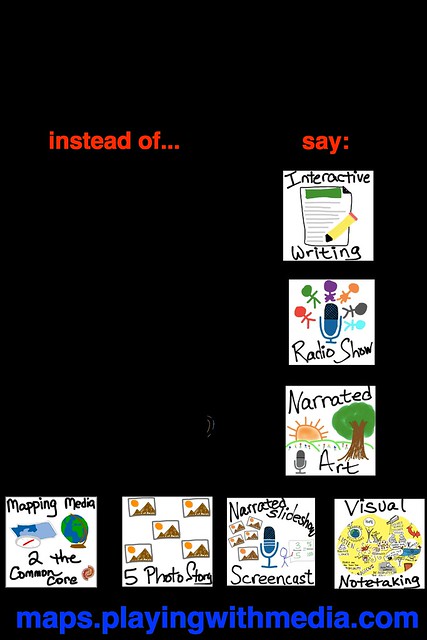(cross-posted from PlayingWithMedia.com)
This Tuesday afternoon, from 1-3 pm, I’ll be sharing a poster session at the ISTE Conference in San Antonio on the topic, “Changing Our Vocabulary as Technology Integration Coaches.” The basic idea is that non-techy terms are important when we want to win the hearts and minds of parents as well as other teachers in our rapidly changing digital information landscape. It’s easy to intimidate or confuse someone with acronyms, when it comes to educational technology or almost any other field. If we can avoid jargon when we talk about media products students can produce to demonstrate their knowledge and understanding of concepts, it can help others open their minds to new possibilities instead of being closed off.
Here is the image I’m using for my actual poster in the session. It’s also available as a PDF file. Feel free to use and share this if it’s helpful to you – The hand drawn graphics are part of the “Mapping Media to the Common Core” website and framework.
These are the paragraphs I’m including in my forthcoming eBook, “Mapping Media to the Common Core: Volume I” on this subject:
Acronyms and jargon can easily confuse and turn-off someone with whom you’re having a conversation. The names of the media products in Mapping Media to the Common Core were deliberately selected to avoid confusion and the “intimidation factor” which can set in when people start using “techy terms.” Instead of using the world “blog,” talk with other teachers about “interactive writing.” Instead of talking about making a podcast, talk about creating a “radio show.” Instead of talking about a specific tool or platform like AudioBoo for recording student voices and adding a related photo, discuss the value of creating “narrated art” together.
All of the media product terms in the Mapping Media framework are worded so they are neither device nor platform specific. While the author is an enthusiastic proponent of using iOS devices (iPads, iPhones, and iPod Touches) to create media products as well as Google’s free web tools like YouTube, Google Docs and Blogger, teachers and students do NOT have to use Apple computing devices nor Google’s web services to create the media products in this framework. Whatever your hardware, software, and connectivity options may be, the author encourages you to “use them well” and help students create multimedia products which can become part of their digital portfolios. Adopt a technology use philosophy similar to this sign in the instructional technology consultants’ hallway in Saskatoon Public Schools, Saskatchewan: “Start where you are. Use what you have. Do what you can.”
Technorati Tags: edtech, iste13, learning, technology, vocabulary, coach, coaching, school, iste



Comments
4 responses to “Changing Our Vocabulary as Technology Integration Coaches”
Just like anything else we do as educators, making it student friendly is the way to go. I also love the title technology integration coach. It is very similar to what my district uses: digital learning coaches.
Often times, I feel that even with other educators we are training and coaching, they become a bit hesitant when we use the technical terms for such projects and developments with technology.
I am looking forward to the book, Wes!
Hi Mr. Wesley Fryer.
I am a student in EDM310 at the University of South Alabama. As an assignment, I have been assigned your blog for the next two weeks to read and comment on blog post. After the second comment, a summary of your blog and my comments will be posted on my blog which can be found here: http://lupaulaedm310.blogspot.com/
And my class blog which can be found here: http://edm310.blogspot.com
I enjoyed reading this post. Everyone should be changing their vocabulary. I agree with you, many people, even now do not know what a blog is or a podcast. I did not even know what a podcast was until I was enrolled in this class. As a future educator, these words would be helpful in describing what we are doing in class and leads to less questions about “what is this” and “what is that?” I think it is a better way to communicate without confusion.
When I first started teaching in a 1:1 environment almost four years ago, the word blog produced serious anxiety. I had no idea how to begin. I was intimidated. If I had not been a newly connected educator, I cannot say I would have entered the blogging world or introduced my students to the “interactive writing.” Thankfully, I was supported in that adventure. Now, I continue to learn and continue to seek support. Language is powerful. When we want to bring people to a digital technology making the journey sound approachable just makes sense. Thank you for this post as I am now entering the world of technology integration coaching.
This makes so much sense. I wonder how many people I have intimidated with techie vocabulary that didn’t sound techie to me at all. [Insert picture of self smacking head with palm of hand while saying “duuuuhhhhhh”]. Thanks: 🙂